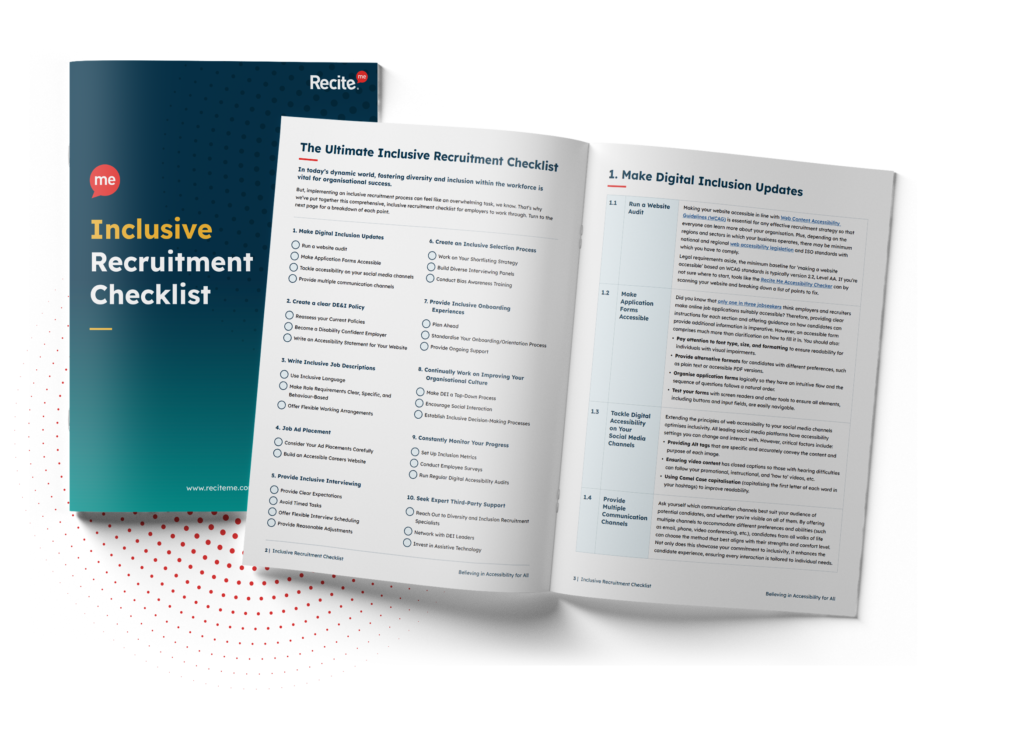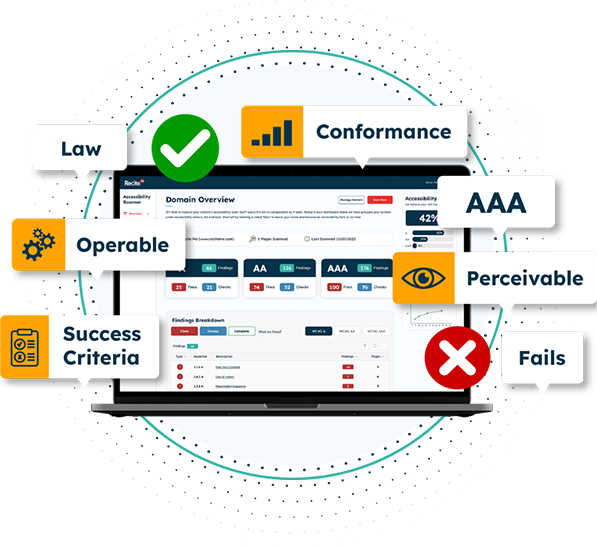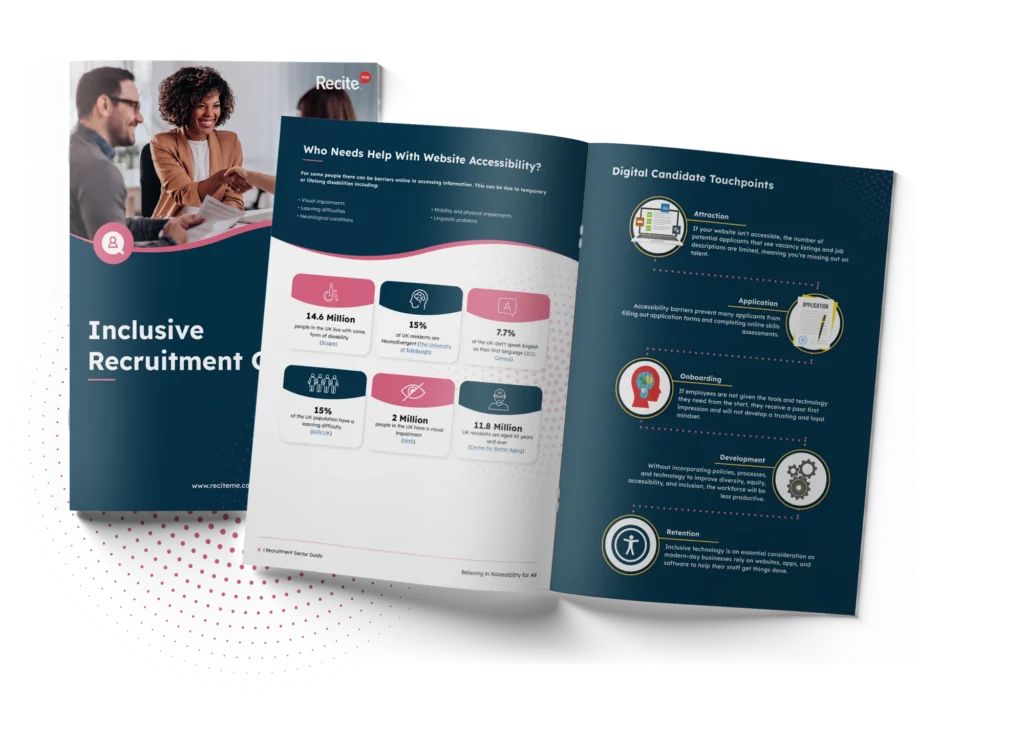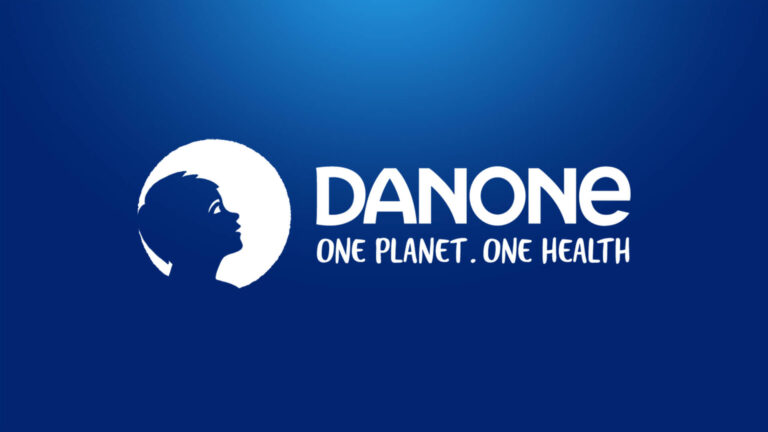Get Your Free Inclusive Recruitment Guide
Download NowA recent study found that 92% of employers were planning on hiring new personnel in the upcoming year, a figure that was consistent with the previous year. This shows how recruitment affects just about every type of business and organisation across the world. So making the right impressions on potential candidates is critical, as another study found that 50% of employees won’t apply to a company with a bad reputation.

What is the Candidate Experience?
The candidate experience refers to the overall journey that a job applicant goes through during the hiring process, from the moment they first encounter a job opportunity to their eventual onboarding or rejection. It encompasses all interactions and touchpoints between the candidate and the employer, including the application process, communication with recruiters or hiring managers, interviews, assessments, and any other relevant interactions.
A positive candidate experience is essential for employers to attract top talent, maintain a good reputation in the job market, and ensure that candidates who are not selected still have a favorable impression of the company. It involves providing clear and timely communication, treating candidates with respect and professionalism, offering a smooth and transparent application process, and providing constructive feedback when necessary. A negative candidate experience, on the other hand, can harm an employer’s reputation, deter potential applicants, and even impact customer relationships if candidates share their negative experiences publicly.
Why is the Candidate Experience Important?
The candidate experience is important for several reasons. Firstly, it significantly impacts an employer’s branding efforts. A positive candidate experience can enhance the reputation of an employer as an attractive place to work. When candidates have a good experience, whether or not they ultimately get the job, they are more likely to speak positively about the company. This positive word-of-mouth can attract more high-quality candidates in the future, contributing to the organisation’s talent pool.
Furthermore, the candidate experience plays a crucial role in talent attraction and retention. In today’s competitive job market, candidates have numerous options available to them. A positive candidate experience can make an organisation stand out amidst the competition and attract top talent. Even candidates who are not selected may reapply for future positions or refer others to the company if they had a positive experience. Furthermore, employees who had positive candidate experiences are more likely to become advocates for the company, which can help with both recruitment and retention efforts.
Moreover, the candidate experience reflects the employer’s values and culture. The way candidates are treated during the hiring process can provide insights into how the organisation values its employees and operates on a day-to-day basis. A positive candidate experience demonstrates to potential employees that the company values respect, transparency, and professionalism. On the other hand, a negative candidate experience can indicate a lack of respect for candidates’ time and efforts, there could also be instances of discrimination, all of which can potentially deter top talent from pursuing opportunities with the organisation.
Download our Inclusive Recruitment Guide
Break down digital barriers and attract the best talent for your business!
Discover hidden talent and recruit from a larger talent pool by providing assistive technology. Support your potential candidates who may be disabled, visually impaired or who speak English as a second language to research and apply for jobs online.
Actionable Methods to Improve Candidate Experiences in the Recruitment Process
There are numerous different tactics and strategies that organisations can implement as part of their recruitment process to help improve candidate experience. Our top ten recommendations for improving your hiring procedures include:
- Clear job descriptions
- Easy application processes
- Showing a high degree of transparency
- Clear, Concise and Frequent Communication
- Provide feedback to all applicants
- Be respectful of candidates and their time
- Outline what to expect at each step of the process
- Give candidates the opportunity to interview via video or in-person
- Share names and profiles of the interviewers before the interview
- Effective Onboarding

#1 Clear job descriptions
Detailed and accurate job descriptions are the cornerstone of a successful recruitment process. They not only outline the role’s responsibilities and qualifications but also paint a picture of what a candidate can expect if they join the organisation. By providing clear information about the position, including key duties, required skills, and desired experience, clear job descriptions help candidates assess their fit for the role.
Moreover, when candidates have a clear understanding of what the job entails from the start, they are more likely to apply with realistic expectations, leading to a better match between candidate and role. Clear job descriptions set the stage for a positive candidate experience by establishing transparency and alignment from the outset, ultimately attracting candidates who are genuinely interested and qualified.
#2 Easy application processes
Simplifying the application process is essential for removing barriers and encouraging more candidates to apply. Lengthy, complex application forms can deter even the most qualified candidates from applying, resulting in missed opportunities for the organiasation. By streamlining the application process and minimising the number of required steps, organisations can make it easier for candidates to express their interest and submit their credentials.
This streamlined approach not only saves candidates time and effort but also demonstrates respect for their busy schedules. An easy application process sends a positive message to candidates that their time and effort are valued, setting a positive tone for the rest of the hiring process.

#3 Showing a high degree of transparency
Transparency is key to building trust and credibility throughout the recruitment journey. Candidates appreciate honesty and openness from employers, as it helps them make informed decisions about their potential fit within the organisation.
By being transparent about the company culture, values, and expectations, employers set clear expectations for candidates and foster a sense of trust and authenticity. Transparency also extends to communication about the recruitment process itself, including timelines, next steps, and potential outcomes. When candidates know what to expect at each stage of the process, they feel more engaged and empowered, leading to a more positive overall experience, regardless of the final outcome.
#4 Clear, Concise and Frequent Communication
Clear, concise, and frequent communication ensures that candidates are kept informed and engaged throughout the process. From initial contact to final decision-making, timely updates and proactive communication demonstrate professionalism and respect for candidates’ time and effort. Regular communication also helps manage candidate expectations, reducing uncertainty and anxiety.
Whether it’s providing status updates on the application process, scheduling interviews, or sharing feedback, maintaining open lines of communication fosters trust and builds rapport between candidates and employers. These strategies can help create a more positive candidate experience and enhance the organisations employer brand reputation.
#5 Provide feedback to all applicants
Offering constructive feedback to candidates, even those who are not selected, is a sign of respect and professionalism. Feedback provides candidates with valuable insights into their strengths and areas for improvement, helping them grow and develop professionally. Moreover, providing feedback demonstrates that the organisation values each candidate’s time and effort invested in the application process.
Even if a candidate is not the right fit for the current role, constructive feedback can leave a lasting positive impression and encourage them to consider future opportunities with the organisation. By prioritising feedback as part of the recruitment process, organisations can differentiate themselves as employers of choice and enhance their reputation for fairness and transparency.
#6 Be respectful of candidates and their time
Respect for candidates’ time is essential for creating a positive candidate experience. Punctuality, responsiveness, and professionalism throughout the recruitment process demonstrate that the organisation values the candidates’ time and effort. Whether it’s promptly responding to inquiries, scheduling interviews efficiently, or adhering to agreed-upon timelines, showing respect for candidates’ time sends a powerful message about the organisation’s culture and values.
Candidates who feel respected and valued are more likely to view the organisation positively, regardless of the final outcome of their application. By prioritising respect for candidates and their time, organisations can enhance their employer brand reputation and reduce the likelihood of candidates not accepting job offers due to a bad experience.
#7 Outline what to expect at each step of the process
Providing candidates with a clear roadmap of the recruitment process helps reduce uncertainty. Hiring managers can do this by outlining what will happen at each stage, including interviews, assessments, and background checks. This transparency also highlights the organisation’s professionalism and positions them as a credible brand worth trusting, as candidates know what to expect and how to navigate each step of the process.
Moreover, clear expectations help candidates feel more engaged and invested in the process, leading to a more positive overall experience. By providing a structured and transparent candidate experience, organisations can differentiate themselves as employers of choice and attract top talent.
#8 Give candidates the opportunity to interview via video or in-person
Offering flexibility in interview formats allows candidates to choose the option that best suits their preferences and circumstances. Video interviews can be more convenient and cost-effective for both candidates and employers, particularly for candidates who may be located remotely or have scheduling constraints. On the other hand, in-person interviews offer a more personalised and immersive experience, allowing candidates to get a sense of the company culture and work environment firsthand.
By giving candidates the option to interview via video or in-person, organisations accommodate diverse preferences and needs, demonstrating flexibility and inclusivity. This flexibility not only enhances the candidate experience but also reflects positively on the organisation’s culture and values. Which helps to highlight the organisation as a place that truly cares about diversity and inclusion in recruitment.

#9 Share names and profiles of the interviewers before the interview
Providing candidates with information about who they will be meeting with before the interview allows them to prepare more effectively. Knowing the interviewers’ names and backgrounds enables candidates to tailor their questions and responses accordingly.
Moreover, sharing interviewers’ profiles humanises the process, helping candidates feel more connected to the organisation and its people. This allows rapport between candidates and interviewers to be built easily, organisations create a more relaxed and productive interview environment. This personalised approach not only enhances the candidate experience but also contributes to a positive employer brand reputation.
#10 Effective Onboarding
A smooth and well-organised onboarding process is essential for setting new hires up for success and integrating them into the organisation seamlessly. Effective onboarding goes beyond administrative tasks to include orientation, training, and ongoing support to help new employees acclimate to their roles and the company culture. By providing new hires with the necessary information, resources, and support they need to succeed, organisations demonstrate their commitment to their employees’ long-term success and satisfaction.
A positive onboarding experience sets the tone for a productive and engaging employee experience, leading to higher job satisfaction, retention, and performance. By investing in effective onboarding practices, organisations not only enhance the candidate experience but also strengthen their employer brand and reputation as an employer of choice.
Attract the best talent for your organisation by becoming an inclusive employer!
Inclusive recruitment doesn’t have to be complicated. This checklist breaks down everything you need to know to attract and retain diverse candidates. Download your checklist today and get started right away.

How to Measure the Success or Failure of your Hiring Process
Measuring the success or failure of your hiring process after implementing the tips and recommendations made in the blog requires a comprehensive approach that assesses various aspects of the candidate experience. Here are some key metrics and methods you can use to evaluate the effectiveness of your hiring process:
- Candidate Satisfaction Surveys: Conducting surveys to gather feedback from candidates about their experience is a valuable way to measure satisfaction. Ask candidates to rate different aspects of the recruitment process, such as communication, transparency, and interview experience. Analysing survey responses can provide insights into areas of strength and areas for improvement.
- Time-to-Hire: Time-to-hire refers to the duration between posting a job opening and making a job offer to a candidate. Tracking this metric can help you assess the efficiency of your hiring process. A shorter time-to-hire generally indicates a more streamlined and effective hiring process, while a longer time-to-hire may suggest bottlenecks or inefficiencies that need to be addressed.
- Offer Acceptance Rate: Monitoring the rate at which candidates accept job offers can provide insight into the attractiveness of your organisation as an employer. A high offer acceptance rate suggests that candidates are satisfied with their experience and excited to join your team, while a low acceptance rate may indicate issues with your employer brand or recruitment procedures.
- Candidate Drop-off Rate: The candidate drop-off rate measures the percentage of candidates who withdraw from the recruitment process at various stages, such as after submitting an application or completing an interview. A high drop-off rate may signal dissatisfaction with the process or highlight specific pain points that need to be addressed.
- Quality of Hire: Assessing the quality of hires made through your recruitment process is essential for evaluating its effectiveness. You can measure quality of hire based on factors such as performance evaluations, retention rates, and contributions to the organisation. Comparing the performance of hires made before and after implementing improvements to your candidate experience can help determine whether the changes have had a positive impact.
- Feedback from Hiring Managers: Requesting feedback from hiring managers about their experience with the recruitment process can provide valuable insights into its effectiveness. Their feedback can help identify areas for improvement and ensure alignment between recruitment goals and organisational needs.
- Employee Turnover Rates: Monitoring employee turnover rates can help you assess the long-term success of your hiring process. High turnover rates may indicate issues with recruitment, onboarding, or organisational culture that need to be addressed.
- Employer Brand Perception: Assessing the perception of your employer brand among candidates and employees can provide valuable insights into the effectiveness of your recruitment efforts. Monitor online reviews, social media mentions, and employer branding surveys to gauge how your organisation is perceived in the job market.
How Inclusive Online Tools can lead to a better Candidate Experience
Accessibility and Inclusivity are two major buzz words in the world of business today. Rightfully so, as it should be one of many core business objectives to help create a more inclusive and accessible environment for current employees, applicants and future applicants. Here at Recite Me we help businesses around the world achieve this goal with the following tools:
Recite Me Toolbar
The Recite Me Accessibility Toolbar is a simple software that installs on to your website to help make it more inclusive. This can be important for the recruitment process as it allows users to customise your website in a way that works best for them. Some of the main features include:
- Personalising font size, type, and colour options.
- Choosing the exact colour contrast between the text and background.
- Utilising the mask screen tool to help with focus.
- Using the ruler tool to make reading easier.
- Downloading content as an audio file as an alternative to reading.
- Converting page content into over 100 on-screen languages.
- Having the page read aloud in a choice of 65 languages.
- Customising PDF documents or having them read aloud/ translated.
- Zooming in on any part of a webpage.
- Using the built-in spell-checker and a fully integrated dictionary and thesaurus.


Recite Me Checker
Our Accessibility Checker can help address inaccessibility at its root cause. As the tool performs a complete scan of your website in line with the latest WCAG standards and guidelines. By following a simple four step process to help improve your websites accessibility:
- Step 1: Scan Your Domains – Choose between scanning single or multiple pages.
- Step 2: Identify Accessibility Issues – Identify the locations of accessibility issues on your website.
- Step 3: Fix Accessibility Errors – Boost your accessibility score by prioritising fixes in line with WCAG Levels A, AA, and AAA.
- Step 4: Track Your Progress – Create and share custom reports with your team and roadmap the next issues in your fix queue.








